Food Chemistry: Chemical reactions in cooking
It is well known from experience that food flavor develops during the heating process (cooking) of foods. For example the caramelization reactions are responsible for the flavors of: chocolate and coffee, freshly baked bread, cakes, cooked meats and others. Reactions at elevated temperatures are important during the preparation of food. Roasting, frying, boiling and baking develop the typical aromas of many foods in which amino acids participate as precursors. Studies with food and model systems have shown that the characteristic odorants are formed via the Maillard reaction and that they are subsequent products, in particular of cysteine, methionine, ornithine and proline (Fig. I.1). The formation of brown products on heating aqueous mixtures of amino acids and sugars was first described by the French chemist Louis Maillard in 1912.

The nonenzymic browning or Maillard reaction is of great importance in food manufacturing and its results can be either desirable or undesirable. For example, the brown crust formation on bread is desirable; the brown discoloration of evaporated and sterilized milk is undesirable. For products in which the browning reaction is favorable, the resulting color and flavor characteristics are generally experienced as pleasant. In other products, color and flavor may become quite unpleasant.
The browning reaction can be defined as the sequence of events that begins with the reaction of the amino group of amino acids (Fig. I.2), peptides, or proteins with a glycosidic hydroxyl group of sugars; the sequence terminates with the formation of brown nitrogenous polymers or melanoidins.

When cooking a casserole with meat (Fig. I.3), the meat should be cooked in oil at high temperatures at the beginning to initiate the Maillard reaction (browning reactions) and release extra flavors.

The reaction velocity and pattern of the process is influenced by the nature of the reacting amino acid or protein and the carbohydrate. This means that each kind of food may show a different browning pattern. Generally, lysine is the most reactive amino acid because of the free l-amino group. Since lysine is the limiting essential amino acid in many food proteins, its destruction can substantially reduce the nutritional value of the protein.
Foods that are rich in reducing sugars are very reactive, and this explains why lysine in milk is destroyed more easily than in other foods. Other factors that influence the browning reaction are temperature, pH, moisture level, metals, oxygen, phosphates, sulfur dioxide, and other inhibitors.
Food chemistry and molecular gastronomy (a new emerging discipline) show us – as it is shown above in the “browning reaction” - the scientific basis of what happens as we cook (and consume) our food. As a conclusion knowledge and understanding of chemistry can be applied to good effect in the domestic and restaurant kitchen.
Relevant Posts
Caramelization in Cooking - Caramelization Reactions
Food Chemistry: Antioxidants and Oxidation Reactions in Foods
Food Preservatives: Sulfites and SO2
References
- H-D. Belitz et al. “Food Chemistry”, 4th Edition, Springer Verlag, 2009
- P. Barham et al., Chem. Rev., 110, 2313 (2010)
- L.H. Skibsted, “Lipid Oxidation Pathways”, AOCS Press: Urbana, Illinois: 2008
- H.E. Nursten, “The Maillard reaction - Chemistry, biochemistry and Implications”, The Royal Society of Chemistry: Cambridge, 2005
Key Terms
preparation of food, food chemistry, molecular gastronomy, Maillard reaction,browning reaction, nonenzymic browning, characteristic odorants in food, caramelization, peptides, proteins, amino acid, sugars, cooking flavor theory, cooking flavor basics, cooking flavor trends, cooking for flavor
No comments:
Post a Comment